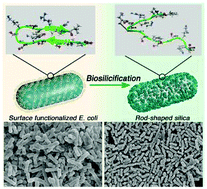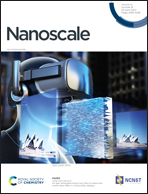Synthesis of monodisperse rod-shaped silica particles through biotemplating of surface-functionalized bacteria†
Abstract
Mesoporous silica particles of controlled size and shape are potentially beneficial for many applications, but their usage may be limited by the complex procedure of fabrication. Biotemplating provides a facile approach to synthesize materials with desired shapes. Herein, a bioinspired design principle is adopted through displaying silaffin-derived 5R5 proteins on the surface of Escherichia coli by genetic manipulations. The genetically modified Escherichia coli provides a three-dimensional template to regulate the synthesis of rod-shaped silica. The silicification is initiated on the cell surface under the functionality of 5R5 proteins and subsequentially the inner space is gradually filled. Density functional theory simulation reveals the interfacial interactions between silica precursors and R5 peptides at the atomic scale. There is a large conformation change of this protein during biosilicification. Electrostatic interactions contribute to the high affinity between positively charged residues (Lys4, Arg16, Arg17) and negatively charged tetraethyl orthosilicate. Hydrogen bonds develop between Arg16 (O⋯H), Arg17 (O⋯H and N⋯H), Leu19 (O⋯H) residues and the forming silica agglomerates. In addition, the resulting rod-shaped silica copy of the bacteria can transform into mesoporous SiOx nanorods composed of carbon-coated nanoparticles after carbonization, which is shown to allow superior lithium storage performance.



 Please wait while we load your content...
Please wait while we load your content...